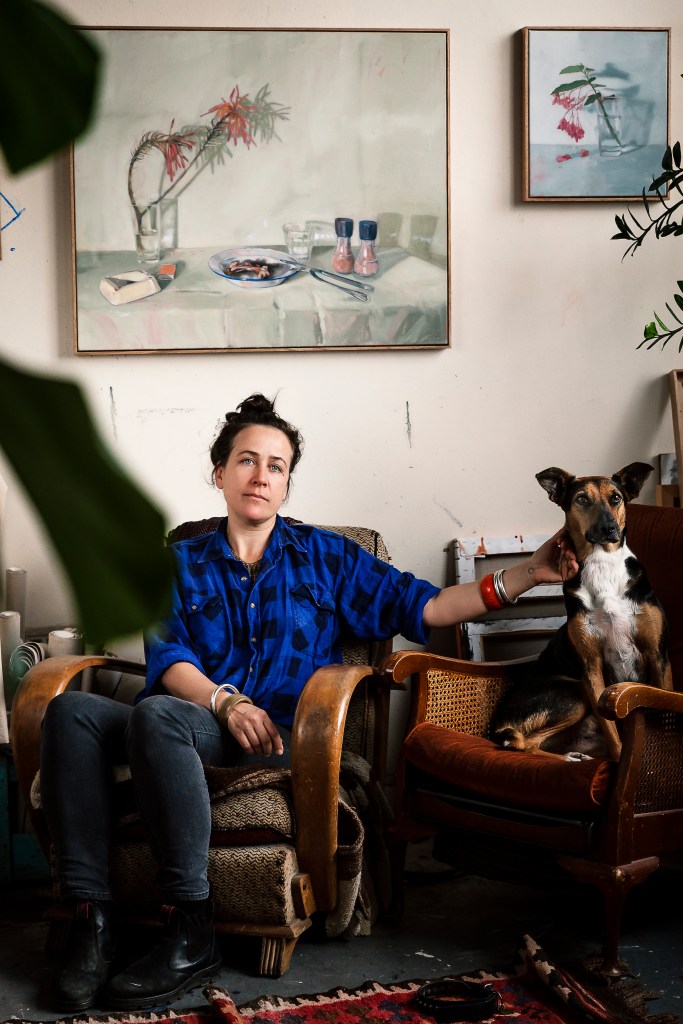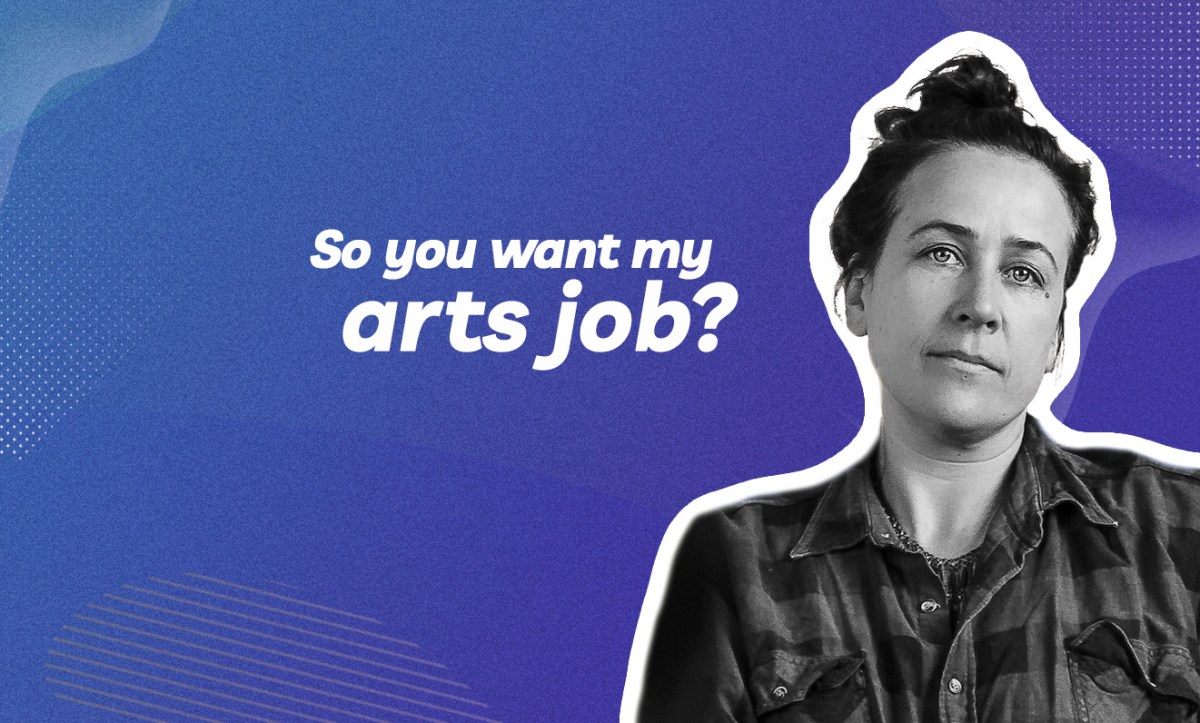Mirra Whale is a painter – a still life painter. She is also a sessional teacher at the National Art School, one of Australia leading art schools. And, recently, she became a new mum. This alone can be a juggle for any professional artist. However, Whale has another string to her bow. For many years, she has been Studio Assistant to the internationally celebrated Australian artist, Ben Quilty.
ArtsHub caught up with Whale to find out exactly what that entails, and how to balance your own practice when you are an assistant to another artist.
How would you describe what you do to your parents or a non-arts person?
I would describe my job as an artist assistant as an extra set of hands, skills and labour that allows an artist to accomplish their works. It’s like building the skeleton and skin of an artwork ready for the artist to adorn… that skeleton could be constructing a painting stretcher or it could be preparing an etching plate ready for line incision and acid, or creating a mould to cast multiples for sculptural works… the list could go on and on.
Maybe it’s best described as using a skillset to make a physical object under the artist’s concept and instructions, a bit like sewing textiles [to a pattern].
What qualifications do you need for this job?
This would depend entirely on which artist you work for. Working with Ben, I am able to use a variety of skills and knowledge that I acquired prior to working for him. For example, I worked in film in scenic painting and props, and worked for years in the scenic department for the City of Sydney events – both these jobs required a variety of skills; for example, welding, wiring, sewing, painting, basic construction and woodwork.
I also did a degree in graphic design after graduating from the National Art School in the early 2000s – these skills have been super handy. I also worked as a framer in Sydney with the brilliant Jim Crofts Studios (Rod Denson).
Ben is always open to exploring different mediums and experimenting, so my role has changed to many mediums over the years – [that keeps] it always interesting and there is always something new to learn, even if it is fixing the jammed underpinner or v-nailer, or battling the air compressor. In a nutshell, working as an artist assistant can not only [broaden] the horizons for the artist you are working with, but also in your own practice. I think all skills are helpful and you can never learn or know too much… there is so much to learn!
How did you get your start in this job?
I stepped in to help with a deadline as an extra pair of helpful hands and ended up staying for years!
How collaborative is this job?
Ben is primarily a painter, so a large portion of the job is stretching linens – but even this is [rather] collaborative sometimes; that is, discussing the size of stretchers for new works and gallery spaces. I have also been lucky to work on many of Ben’s projects, from casting resin frames to editing suites of etchings and woodblock prints, sewing large textile works, welding structures, and even cooking and designing menus around his work for shows.
There was one (very large) sculptural work that we worked on collaboratively from conception to finish, titled Not a Creature was Stirring (2018). It stands 3.7 metres tall, is four by four metres wide and was primarily constructed using discarded lifejackets collected from the shores of Greece. All the sewing, welding, wiring and light sequencing was done from his Southern Highlands studio.
But one of the biggest collaborative feats was collating and designing Ben’s monolithic 350-page book and catalogue that spans 20 years of his practice, titled Ben Quilty.
What’s an average week like?
I generally work two days a week for Ben. This involves keeping on track of materials and ordering paint, stretcher bars, linen, general hardware, glass, framing moulding etc [and] building brackets and travel frames. It also involves keeping up-to-date with Chris, who is Ben’s studio manager. Sometimes, it involves researching a new material that I will be working with; for example, different resins and silicones when we are casting frames. Often it will involve a home cooked lunch.

What’s the most common misconception about your job?
Gosh, I don’t know. We have completely different painting styles so there is no misconception of [me actually] painting his paintings!
How competitive is this job?
It is a great job. Ben is a legend, one of the most generous and thoughtful friends (and bosses) out there, so not only do you learn and use a wide variety of skills within the role, which keeps it ever changing and interesting, it is also a great workplace and family to be part of. I’m sure there are lots of artists who would love to work at the studio.
In an interview for your job, what skills or qualities would you be looking for?
I’d look for someone who has a wealth of experience within the arts (primarily an artist themselves), but also in other fields that can complement one another or bring something else to the table. There is a lot of trust and respect when working with someone, especially in a small, intimate team of people, and in this role this is key. Another quality is self-initiative – you are your own boss here.
How do you get the balance right between your own practice and the one you manage?
Always a juggle! Working two days a week for Ben is a good balance to juggle my own practice and lecturing. (I also teach as a sessional lecturer at National Art School, so it often is finding the balance between the three.)
One of the wonderful things about working with Ben is his feedback on my practice and the inspiration from working with such a prolific artist. He is very supportive of my practice, and if ever I have deadlines for a show he will accommodate and be flexible with work hours. I am always invited when there is a life model to draw and paint, and am welcome to use his studio when he isn’t there, not to mention being able to stretch my own linens and frame my works in the studio.
Read: Being a studio assistant has ‘opened up my mind set’
What’s the most interesting thing that’s happened to you in this job?
I wouldn’t know where to start! All of the above. I have met many interesting people from all walks of life that have come through Ben’s studio, from musical icons to Afghan war veterans to friendly neighbours. It’s always a surprise.
More about Mirra Whale
Whale gained a Bachelor of Fine Art in Printmaking at the National Art School in 2003 and a Diploma of Graphic Design and Communication in 2010. She studied at Julian Ashton College (2011) and achieved Honours at the National Art School in 2012.
Whale has also been a finalist for several art prizes including the Archibald Prize, Kedumba Drawing Award, Hurford Hardwood Portrait Prize, Salon Des Refusés, Portia Geach Memorial Award, AME Bale Art Prize, Hornsby Art Prize, Mortimore Prize and the Manning Gallery Prize.
In 2019 Whale was the winner of the Eutick Memorial Still Life Award (EMSLA) and won the Royal Art Society of NSW (North Sydney) Drawing Prize in 2011. She shows with Mitchell Fine Art.




